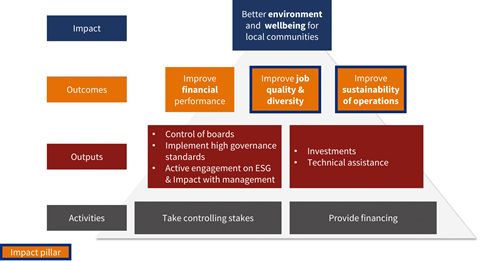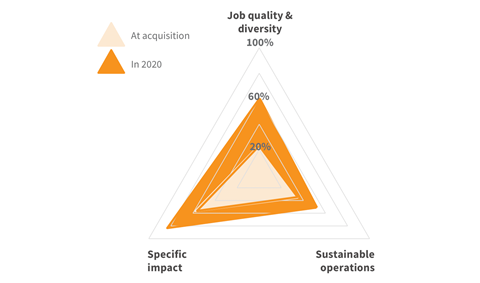Adenia Partners
- Investment manager
- Mauritius
- EUR325,000,000
Adenia believes in the convergence between strong financial returns and positive social impact. We recognise that businesses have an urgent role to play in the transformation of our global production, distribution and consumption model. This case study shows how Sustainable Development Goal (SDG) outcomes contribute to our impact management and measurement framework whereby we set targets, monitor outcomes and report progress.
Why we focus on SDG outcomes
Taking into account risks and opportunities linked to our chosen SDG outcomes enables us to make better investment decisions and increase the value of our companies while positively contributing to the SDGs.
We decided to focus our efforts on two areas that are amongst the most pressing in Africa and which align with our expertise and our overall company transformation strategy as an investor with controlling stakes :(i) SDG 8 (the improvement of job quality) and (ii) SDG 9 (the improvement of standards and infrastructure).
- SDG 8. More than in any other region, having a job in Africa is not a pathway out of poverty, often due to low earnings and poor working conditions. Being present in more than 20 low-income countries in Africa, we decided to prioritise job quality in our impact strategy.
- SDG 9. Through due diligence we identify, measure and control the residual industrial and environmental risks associated with our investees. However, their sustainability can still be improved through investments and industrial processes targeted at improving operations and infrastructure and reducing their environmental footprint. This is particularly important on the continent that is foreseen to be the most struck by the impacts of climate change.
Finally, we believe that, whenever relevant, our companies should contribute to the advancement of sector-specific SDGs. These SDGs are identified during the due diligence phase by our investment team, which also sets targets and determines the initiatives to be implemented to shape outcomes.
How we focus on SDG outcomes
Our Theory of Change process focuses on two main long-term impact targets (SDG 8 and 9) mentioned above, and another specific SDG where deemed relevant. Alongside IBIS Consulting and financing support from Swedfund, we designed an impact management and measurement framework that sets achievable SDG-aligned targets, which contribute towards achieving these outcomes, also known as our impact pillars.
Our Theory of Change

We set pragmatic targets relating to the specific impact to be generated by our investees based on what Adenia and investee management teams believe can be achieved. This translates into targets that are generally more ambitious than national targets, using objective quantitative and qualitative data as well as direct feedback from investee company employees.
To monitor our progress on targets, every year we track and report two sets of performance indicators: company-specific criteria and our job quality and standard and infrastructure indicators. These performance indicators were developed using the SDGs, IRIS and other existing frameworks. We have chosen indicators that fit our strategy, that can be measured, that we can influence and that ensure measurable positive change for the beneficiaries.
This data is summarised in an impact scorecard, whereby a score of 100% means that Adenia’s long-term objective has been achieved.
Example of impact score

Example: Setting targets and measuring progress on decent work
SDG 8
Adenia’s first long-term goal is to ensure that all investee companies provide high-quality employement. We aim to contribute to UN target 8.5: by 2030, achieve full and productive employment and decent work for all women and men, including for young people and persons with disabilities, and equal pay for work of equal value.
Indicators
For us, job quality goes beyond salary (or more specifically, the salary paid to non-management employees compared to legal minimum of each employee’s category). We also consider diversity, wellbeing, growth opportunities as measured by objective indicators, as well as job satisfaction, measured by an annual survey of all employees.
Examples of indicators which capture these aspects include:
- gender balance in management teams and on boards;
- extent and nature of social benefits, training and career growth opportunities for all;
- flexibility of work arrangements;
- work accidents;
- occurrence of strikes;
- job satisfaction.
In addition to asking the investee company for data on these indicators, we also ask questions directly to the employees. Employee surveys seek to measure qualitative aspects of their jobs, and cover:
- equality in accessing promotion and training opportunities;
- employee representation in the workplace;
- job meaningfulness as captured by employees’ assessment of their contribution to growth and improvement of their company;
- fairness of package and managerial assessment;
- respect; and
- net employer promoter score (percentage of employees who are likely to recommend the investee as a place to work).
Targets
Example targets include ensuring that all employees have access to social benefits, training, career growth opportunities and flexible work arrangements before we exit the company. Moreover, for all new investees, we aim to implement a gender-related policy during our holding period, and we are working on clear, quantitative, outcome-based targets on gender that aim to contribute to SDG 5.1 and 5.5. We are continuously working to strengthen our framework.












